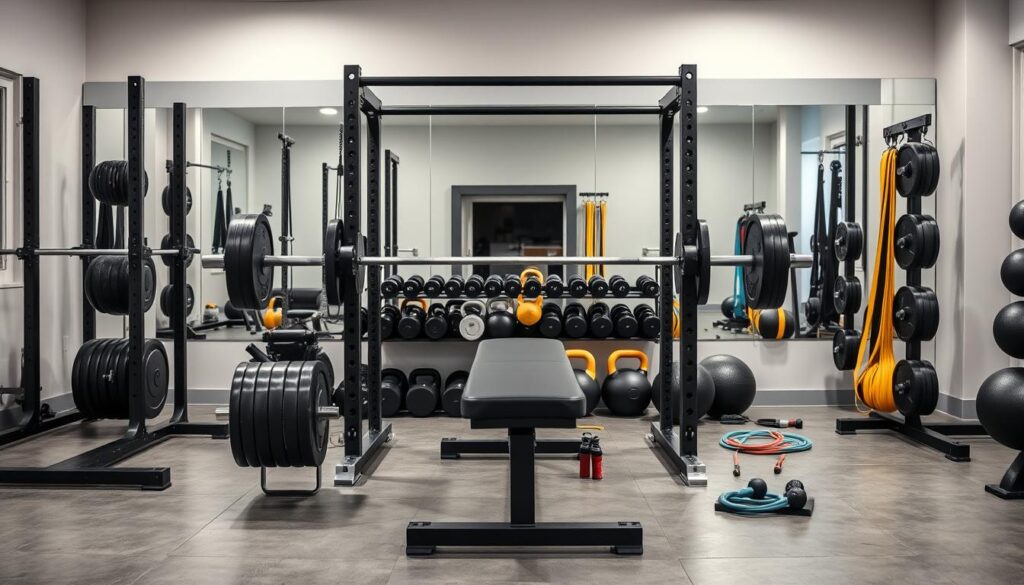Building muscle is more than just lifting heavy. Studies show that doing more reps and sets is key. This helps muscles grow. Even beginners can gain muscle with the right training.
Don’t believe the myths. Both men and women can reach their goals with science. Start with 4 days of exercises like squats and bench presses. Eat lots of protein and watch your progress over 3 weeks.
I want to share tips that help you see results. We’ll talk about eating right, training well, and resting enough. By the end, you’ll know how to work out, eat well, and avoid mistakes.
Key Takeaways
- Workout volume (sets/reps) matters more than gym frequency for muscle growth.
- Stick to 10-12 reps per set for hypertrophy, paired with 3-4 sets per exercise.
- Eat 3,500 extra calories weekly to gain 1 pound of muscle, adjusting by no more than 500 calories daily.
- Beginners should train 4 days weekly, focusing on compound lifts like deadlifts and bench presses.
- Track progress over 3 weeks to avoid discouragement from daily weight fluctuations.
Understanding the Science Behind How to Gain Muscle By Weight Lifting
Building muscle is more than just lifting weights. It’s a science. Let’s explore the key principles of muscle growth through weight training and how to use them well.
The Muscle Building Process: Hypertrophy Explained

Hypertrophy means muscles get bigger. There are two kinds: myofibrillar hypertrophy (for strength) and sarcoplasmic hypertrophy (for size). Men and women have different hormones, like testosterone, that affect how they grow muscles. But, with the right plan, anyone can see muscle growth.
Progressive Overload: The Foundation of Muscle Growth
Progressive overload means making your muscles work harder over time. Start with a weight you can lift 10 times, but the last two should be hard. Then, add 5% more weight every 2–3 weeks. For example, if you lift 100 lbs, try to lift 105 lbs next time.
“Progressive overload isn’t just about lifting heavier—it’s about consistent, incremental progress,” says Dr. Jane Smith, a sports nutritionist.
- Keep track of your progress in a workout routine journal.
- Do compound lifts like squats and deadlifts for muscle development.
- Women, don’t lift too light. Challenge yourself!
Rest and Recovery: When the Real Growth Happens
Muscles grow when you rest. Sleep 7–9 hours a night to boost growth hormone, key for gain strength. Rest times between sets are important too:
- 2–5 minutes for strength (progressive overload focus).
- 30–90 seconds for size (hypertrophy focus).
Don’t overtrain. Listen to your body and include rest days in your gym workouts plan.
Use these muscle building tips with good nutrition. Eat enough protein (3–4 grams of leucine per meal) and calories to support your resistance training goals. Now, let’s apply this science to your journey!
Essential Equipment and Gym Setup for Maximum Gains
Start your gym setup by choosing the right weight training equipment. Focus on tools for big moves like squats and rows. Things like adjustable dumbbells and a strong bench are key.
The Bowflex SelectTech 552 adjustable dumbbells are great. They save space and money. They replace many pairs of dumbbells.

Get a power rack like the REP Fitness PR-5000 for safety. It’s worth $900. Also, get resistance bands from EliteFTS for $30. They’re good for pull-ups and rows.
Choose muscle building equipment that lets you lift more. Things like Olympic plates are important. Don’t spend too much on fancy stuff yet.
- Rogue Ohio Bar ($295) for heavy lifts
- AssaultBike Classic ($749) for cardio bursts
- TRX Home2 System ($230) for bodyweight training
“A cluttered gym breeds inconsistency. Keep your space clean, safe, and focused on results.”
Even simple setups can work well. Use a journal to track your progress. Remember, being consistent is more important than having lots of gear. Start with the basics and add more as you go.
Mastering Proper Form and Technique for Injury-Free Progress
Good weightlifting form is key for safe and effective workouts. It helps you lift heavy and target muscles well. Start with these tips to build a strong base:

Compound Movements: The Backbone of Any Strength Program
Compound exercises like squats and deadlifts work your whole body. Focus on controlled movements to get the most out of them. For example, keep elbows at 45 degrees during bench presses to protect your shoulders.
Beginners should start with lighter weights and 12-rep sets. This is what NASM recommends. Remember, good form is more important than how much you lift.
- Brace core muscles before lifting to stabilize your spine
- Use a mirror to check alignment during squats and rows
- Pause briefly at the bottom of lifts to maintain tension
Isolation Exercises: Targeting Specific Muscle Groups
Isolation exercises like biceps curls and triceps extensions help target specific muscles. Use slow, 3-4 second movements to activate muscles better. For example, pause at the peak of lateral raises to feel your shoulders working.
Do these exercises with compound lifts for a balanced workout.
Mind-Muscle Connection: Feeling Every Rep
“Concentratingion on the working muscles improves hypertrophy outcomes by 15-20%,” says a 2023 study in the Journal of Strength & Conditioning.
Focus on feeling each muscle work during rows and presses. Start with lighter weights to get the hang of it. Then, increase the weight while keeping your focus on proper form.
Breathing Techniques That Enhance Your Lifts
Learn bracing techniques to improve your lifts. Exhale hard during the effort phase of lifts like deadlifts. For heavy sets, inhale deeply, hold your breath briefly, then exhale slowly.
This helps keep your core stable and prevents back strain.
Use these tips with progressive overload. Always choose proper form over lifting too much. Small changes in form can lead to better results and faster gains.
Building the Perfect Workout Routine for Your Body Type
Creating a weight lifting regimen for muscle gain begins with knowing your body types. Ectomorphs, mesomorphs, and endomorphs react differently to workouts. A personalized workout mixes your genetics with achievable goals. Let’s look at how to set up your weightlifting program with effective training splits.
Beginners do best with a full-body training split. Studies in the Journal of Strength and Conditioning Research show it builds muscle faster than other splits. For instance:
- Full-Body (3x/week): Squats, bench presses, and rows work big muscles.
- Upper/Lower Split (4x/week): Switches between upper and lower body days for even growth.
- Push-Pull-Legs (5x/week): Focuses on specific movements for advanced lifters.
Here’s a table to compare splits:
| Split | Frequency | Best For |
|---|---|---|
| Full-Body | 3x/week | Newcomers, time-crunched lifters |
| Upper/Lower | 4x/week | Moderate volume seekers |
| Push-Pull-Legs | 5x/week | Advanced athletes |
Combine this with progressive overload—like adding 1 kg each week—to see gains. The best weightlifting program changes as you get stronger. Keep track of your progress and tweak your splits as needed!
Nutrition Strategies That Fuel Muscle Development
Your workouts are the spark, but your diet is the fuel. Pairing protein intake with smart meal planning turns every rep into real gains. Here’s how to align your nutrition with your goals.
Protein Requirements: The Building Blocks of Muscle
I recommend eating 0.8–1 gram of protein for every pound of your body weight each day. A 180-pound person needs 144–180 grams, spread out in meals. Foods like chicken or eggs have all the amino acids you need.
Plant-based eaters should mix legumes and grains to get enough protein. Try to eat 25–35 grams of protein at each meal to keep muscles growing.
Timing for Optimal Growth
Eat protein with carbs before and after working out. This helps fuel your workout and helps you recover. A 250–500 calorie surplus helps you grow, but choose quality over quantity.
For example, a 180-pound person might eat 2,950 calories a day. Focus on whole foods like grilled salmon, Greek yogurt, or tofu first. Then, use powders if needed.
Smart Choices for Every Diet
Choose different protein sources like chicken, beans, or cottage cheese. After working out, eat protein with carbs to refill glycogen. Don’t overdo it on supplements; whole foods give you fiber and nutrients.
Being consistent with these tips makes every meal a step towards your goals.
FAQ
What is hypertrophy, and how does it relate to muscle growth?
How can I incorporate progressive overload into my training?
Why is recovery important for muscle growth?
What equipment do I need for an effective weightlifting program?
What are compound movements and why are they important?
How do isolation exercises fit into a workout routine?
What is the mind-muscle connection, and how can I develop it?
How important is breathing technique during weightlifting?
How should I set up my workout routine based on my body type?
What are the protein requirements for muscle building?
Disclaimer: AI-Generated Content, AI makes this blog and all images